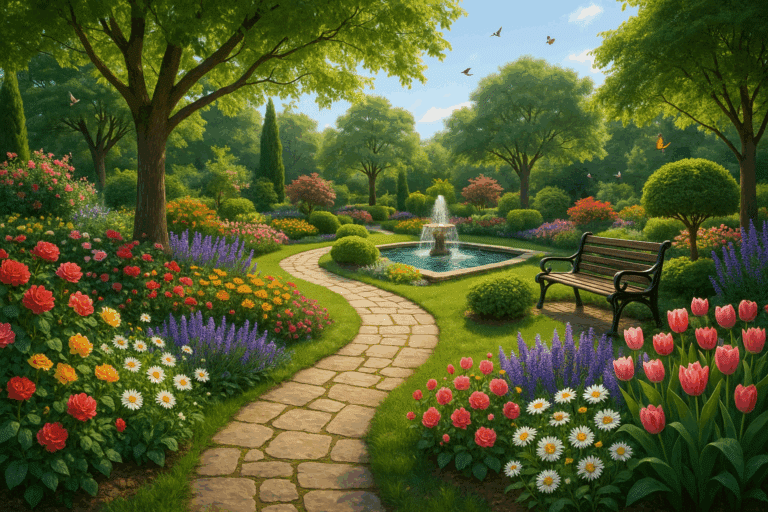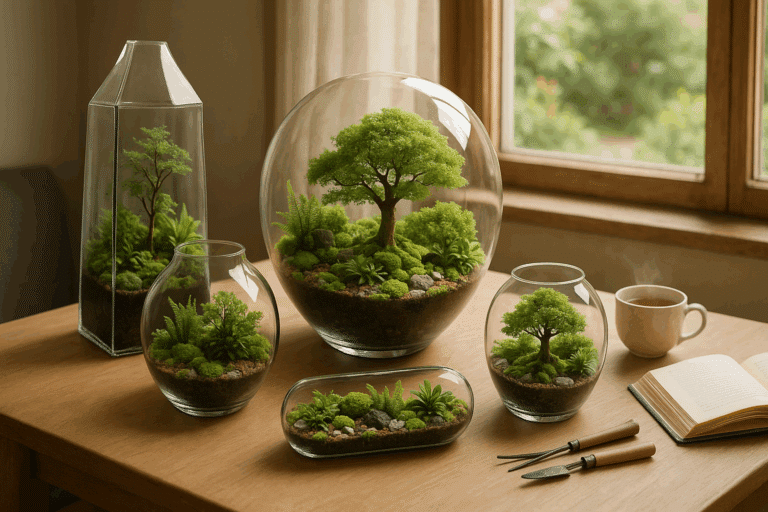🌿A place where nature blends seamlessly with your interior design, creating a space that not only enhances the aesthetic appeal of your home but also contributes to your mental and physical well-being. Welcome to the world of cozy plant nooks.
In an increasingly urbanized world, reconnecting with nature is more important than ever. The concept of biophilia suggests that humans have an innate tendency to seek connections with nature. 🌳This may explain the recent surge in popularity of indoor plants, and the creation of tranquil spaces within homes dedicated to showcasing these green gems. But creating a cozy plant nook goes beyond just placing a few pots on a shelf. It’s about thoughtful design, choosing the right plants, and nurturing an environment that will thrive indoors.
Introducing a plant nook in your home can have a transformative effect. It can be a quiet spot for a morning coffee ☕ or an evening wind-down, a space that sparks creativity, or even a personal sanctuary that brings you closer to nature. In this guide, we’re going to delve into the world of cozy plant nooks. We’ll explore the benefits, delve into the design elements, and provide practical advice on plant selection and care.
The Benefits of Creating a Plant Nook in Your Home
The benefits of introducing indoor plants and creating a dedicated plant nook in your home are multi-faceted. 🌿 From improving air quality and humidity levels to reducing stress and boosting productivity, the positive impacts of greenery on our mental and physical health are well documented. We will explore these benefits in depth, equipping you with the knowledge you need to make informed decisions about creating your perfect plant nook.
Design Elements of a Cozy Plant Nook
Creating a cozy plant nook involves more than just putting plants in a corner of your room. It requires a thoughtful approach to design. Whether you are working with a small space or a large room, we’ll explore various design elements that can make your plant nook not only functional but also aesthetically pleasing. From furniture and shelving to lighting and color schemes, we will cover all the essential components of a well-designed plant nook. 🏠
Choosing the Right Plants
Choosing the right plants for your plant nook is an essential step in the process. The plant selection should consider not only the design and aesthetic aspects but also the specific conditions of your space like lighting, temperature, and humidity. 🌱We will guide you through the process of selecting the right plants for your space, considering factors such as plant size, growth patterns, and maintenance requirements.
Caring for Your Plant Nook
Maintaining a plant nook goes beyond watering the plants. It involves understanding their individual needs, providing the right nutrients, ensuring they are getting enough light, and more. In this section, we will provide practical advice on how to care for your plant nook, including watering techniques, light requirements, and dealing with pests and diseases.
Ready to embark on this green journey? Let’s dive into the world of cozy plant nooks and transform your space into a serene and stylish escape. 🍃
Unleash the Magic of Cozy Plant Nooks in Your Home
Imagine stepping into a room filled with vibrant greenery, where the air is naturally purified and the space feels inherently serene. This is the magic of cozy plant nooks. These tranquil corners bring a piece of nature indoors, enhancing your home’s aesthetics and your mental health. But creating these stylish nooks requires some technical know-how and a dash of creativity. So, let’s delve into the world of indoor plant nooks to help you transform your space into a serene escape.
Creating a plant nook doesn’t necessarily require a large space or a huge budget. A small corner, a few plants, and some creativity can be enough to get started. But, understanding the needs of different plants, knowing how to arrange them and how to care for them are crucial aspects. Here is where engineering concepts come into play, with considerations like light conditions, humidity levels, plant compatibility, and structural stability.
To make your journey into plant nook creation smoother, we’ll explore different styles, the technical aspects of plant care, and tips to maximize the use of your space. We’ll also provide a comparative table of popular indoor plants to guide your plant selection process. So, let’s dive in and start crafting your cozy plant nook!
Styles of Plant Nooks: Unleashing Your Green Thumb Creativity
The style of your plant nook should ideally blend with your overall home decor. It should be a space that invites you in, offering a soothing ambiance. From minimalist designs to jungle-like feels, let’s explore some popular styles:
Minimalist Plant Nooks: These nooks are about simplicity and subtlety. With a few carefully selected plants, they can create an understated yet impactful green space. Succulents and snake plants are great for minimalist nooks because they are aesthetically pleasing and require minimal maintenance.
Jungle-Inspired Plant Nooks: These nooks are for the daring plant lovers. They are lush and dense, filling every inch of your nook with greenery. Ferns, ivy, and peace lilies are popular choices for a jungle-inspired nook. To further enhance the jungle vibe, consider adding some plant-themed decor, like a jungle-themed wallpaper or wall art.
For a more visual understanding of these styles, check out this video titled “Plant Nook Inspiration and Ideas” from the YouTube channel “Plantify.”
Selecting Your Indoor Plants: A Comparative Overview
Choosing the right plants for your nook is crucial. To help you in this decision, here is a comparative table of popular indoor plants. Remember, each plant has its specific light, water, and care requirements.
| Plant Name | Light Requirements | Watering Frequency | Additional Care |
|---|---|---|---|
| Snake Plant | Low to Bright Light | Every 2-3 weeks | Requires well-drained soil |
| Peace Lily | Medium to Bright Light | Once a week | Needs high humidity |
| Fern | Medium to Bright Light | 2-3 times a week | Needs high humidity and regular misting |
| Succulent | Bright Light | Every 2-3 weeks | Requires well-drained soil and infrequent watering |
For a more detailed guide on plant care, watch the video “Indoor Plant Care: A Beginner’s Guide” from the YouTube channel “The Houseplant Guru.”
Maximizing Space and Light in Your Plant Nook
Once you’ve decided on the style and plants for your nook, the next step is to consider the space and light conditions. Even if you have a small space, there are creative ways to maximize it for your plant nook.
Using vertical spaces is a smart way to display more plants without cluttering the floor area. Floating shelves, wall-mounted pots, and hanging planters are great options. For larger spaces, you can use plant stands, ladder shelves, or even create a mini greenhouse.
Light conditions are critical for plant health. Some plants thrive in bright light, while others prefer low light. Position your plants according to their light requirements, and use artificial plant lights if necessary. For a technical understanding of plant light needs, watch the video “Plant Lighting Basics” from the YouTube channel “Epic Gardening.”
Creating a cozy plant nook can transform your space into a serene and stylish escape. It’s a blend of art and science, creativity and technical understanding. It’s about knowing your plants, understanding their needs, and arranging them in a way that enhances your space and your mood. So, start planning, get creative, and let the magic of plant nooks enrich your home and your life.

Conclusion
In conclusion, it’s vital to note the significant role that Software Engineering plays in our current digital era. From the design phase to the final implementation, each stage is crucial in building software that not only meets but exceeds the user’s expectations.
We’ve journeyed through the various stages involved in the Software Development Life Cycle (SDLC), beginning with the requirements analysis, where the needs of the end-users are considered. This stage is followed by the design phase, where a software architecture is developed to meet these requirements.
Next is the implementation phase, where the design is converted into the final product, and after this comes the testing phase, which ensures that the software functions as expected. The maintenance stage ensures that the software remains effective in meeting user’s needs even after deployment.
We also discussed how Software Engineering principles like modularity, reusability, and abstraction have a significant role in improving software quality and efficiency.
This article has further delved into the different types of software like system software, application software, and embedded software, each serving a unique purpose in the digital environment.
Moreover, we’ve highlighted the importance of good software documentation in promoting understanding and facilitating maintenance. The use of Unified Modeling Language (UML) diagrams was discussed as an effective way of visualizing the system’s structure.
By understanding these concepts, we can appreciate the intricacies involved in software development and appreciate the efforts of the software engineers in making our digital experience seamless.
It is essential to keep in mind that the field of Software Engineering is continuously evolving with new technologies and methodologies. As such, continuous learning and adaptation are required to stay relevant in this dynamic field.
If you found this article informative and valuable, do share it within your networks. Also, don’t hesitate to leave your thoughts and questions in the comments section. Your feedback can spark further discussions, contributing to the collective knowledge in this area.
Remember, the world of Software Engineering is vast, filled with numerous opportunities for innovation and advancement. Let’s strive to learn more, share more, and do more. Let’s harness the power of technology to create a better future. 🚀
For further reading, you may find these resources helpful:
1. [Software Engineering: A Practitioner’s Approach](https://www.amazon.com/Software-Engineering-Practitioners-Roger-Pressman/dp/0078022126)
2. [Clean Code: A Handbook of Agile Software Craftsmanship](https://www.amazon.com/Clean-Code-Handbook-Software-Craftsmanship/dp/0132350882)
3. [IEEE Xplore](https://ieeexplore.ieee.org/Xplore/home.jsp)
Please note that all these references were active at the time of writing this article. Happy reading! 👓
Remember, knowledge shared is knowledge multiplied. 😊 Let’s continue to learn, grow, and shape the future of technology together.



